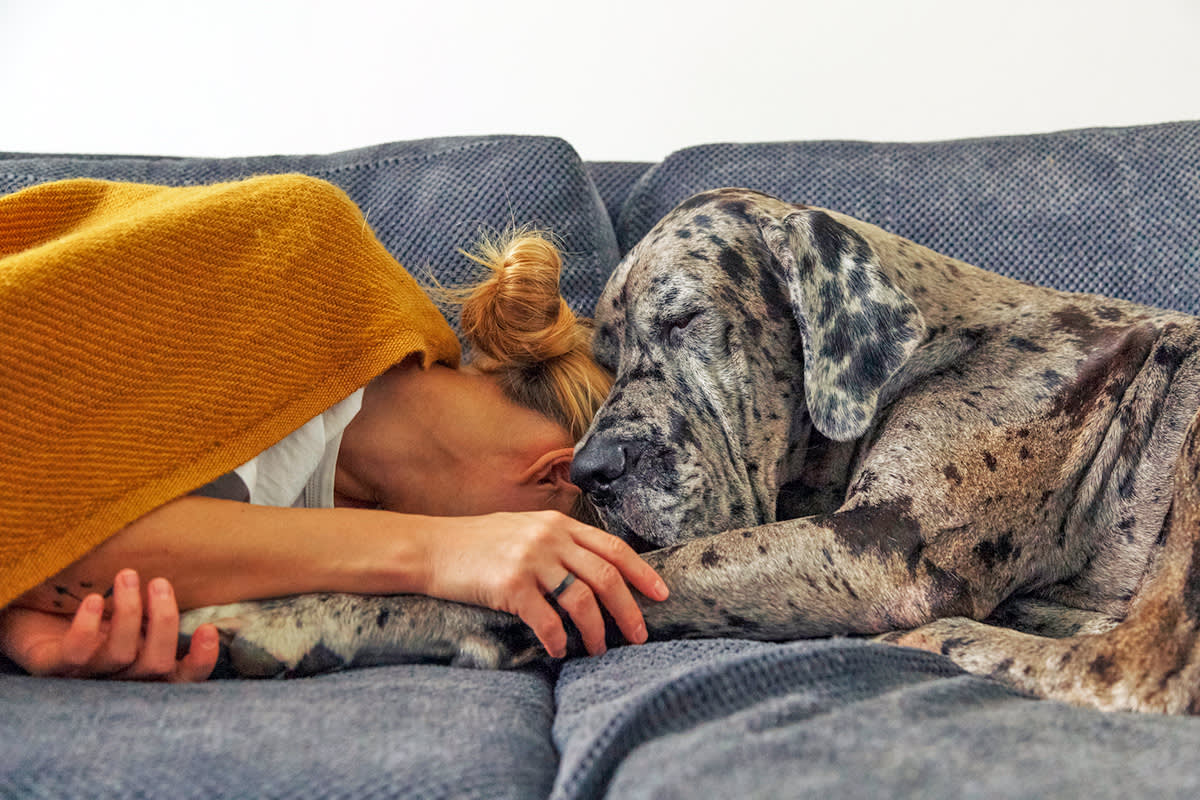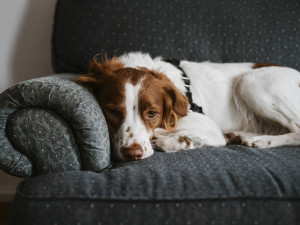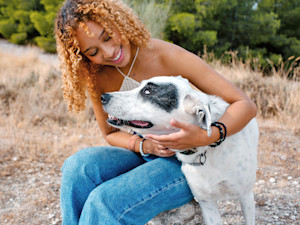Does Your Dog Get Sad When You’re Sad?
They can tell when you’re in a state of ennui. Learn if that bums them out.

Share Article
Did you accidentally “reply all” and tell the whole company far-too-personal details about why you will be out of the office and can’t make a meeting? Or maybe you walked into a conference room — only to bang right into a glass door?
Anything can catapult a perfectly normal day into a lousy one, and from there, who knows how low you can go? But there’s nothing like arriving home to a creature who accepts you for who you are (and does not care that you inadvertently called your boss Mom).
Scientists have found that dogs know when we’re feeling down. But what happens if that bad day or moment festers into a lingering sadness? Maybe you’re grieving or maybe you have a tough medical condition, or maybe you’re just upset about the state of the world (valid). Sometimes, it’s not possible to shake off the blues like you shook off the embarrassment of announcing to the whole team you’d rather eat dirt than play pickleball at the company off-site. In some cases, it might take time to get better.
And that might make you wonder if your sadness can make your dog sad, too.

What does science say about our relationship with dogs?
Studies have actually shown that dogs recognize our emotionsopens in new tab, and they’re even good at mirroring our behavior. “Dogs can tune into our emotions and can recognize when their people are stressed, tense, happy, worried, sad or upset,” says Tatiana Yastremskiopens in new tab, a certified dog trainer and canine behavior consultant at St. Hubert’s Animal Welfare Centeropens in new tab in Madison, New Jersey.
One study showedopens in new tab that dogs can even smell human stress via a hormone called cortisol, which means that if you’re fretting over something, your dog is going to pick up on it. “They are also keen on observation and will observe the smallest changes in our body, from tensing our bodies to a change of facial expressions,” says Dr. Ambika Vaid, an integrative veterinarian and pet food adviseropens in new tab in Denver.
What’s more, the longer you’re togetheropens in new tab, the more your emotions — or at least your stress levels — are linked. So, that means that not only is there a possibility you and your dog act similarly (it’s scienceopens in new tab!), but your emotions may also be synced.
Can our sadness make our dogs sad?
In most cases, stress has been studied more than “sadness” in our pups. As to whether dogs become sad when we are, the explanation is trickier. Vaid doesn’t exactly think our dogs mirror sadness.
“Our dogs do not necessarily get sad when we are sad; more so, they become aware of it and want to comfort us,” says Vaid, whose dog cuddles or nuzzles her when she’s down. “Dogs tend to mirror more stress and anxiety from us than sadness.”
It’s natural to worry that your dog may be upset if you are; after all, you want the best for your bestie. But it’s important not to assume they’re feeling something they might not be. “I know that as humans, we want to believe that our dogs’ response to our feelings of sadness is because they also feel sad,” Yastremski says, but that’s not necessarily the case. “Our dogs observe us and our body language very keenly. While they may not feel sad when we’re sad, they will likely match your activities or behaviors.”
That means that if you’re less active, they probably will be, too. So, if they’re sleeping more, it’s probably because you’re sleeping more, and they’re just following suit. And rather than an emotional reaction to our sadness, they may experience an environmental reaction. For example, when they see that you’re upset, your dog might grab onto a toy and chew intently, according to Yastremski.
“I don’t necessarily think that they feel exactly the way we feel, but they could respond to our sadness with specific behaviors that may indicate they are uncomfortable,” she says.
How can you tell if your dog is feeling down in the dumps?
While it’s not really accurate to say that your dog is “sad,” they can definitely have changes in their emotional states that result in grumpiness, for a variety of reasonsopens in new tab. You might note a sudden drop in energy, lack of appetite, sleeping too much, panting, withdrawing, or becoming clingy, Vaid says.
Because they may mirror your behavior, “they may nap, they could appear a little lethargic, they could whine, or sigh deeply as they are finding a spot to lie down, or they may engage in mischief because they are bored,” Yastremski adds.
How can you keep your dog happy?
Vaid says that it’s important to stick to your pet’s routine as much as possible to keep them feeling safe and secure. And, it should go without saying, you have to take care of yourself. “Taking the time to journal, going on long walks with our pups, and dealing with our sadness helps prevent our pets from taking on those emotions with us,” she says.
As this trainer notes on TikTokopens in new tab: “The first thing to do if you really want to help your dog is to help yourself.” It’s similar to a phrase — “You can’t help others until you help yourself” — uttered by many a therapist.
It might be wise to realize, too, that as long as your dog is getting their needs met during a brief difficult time (that means, adequate food and nutrition, regular exercise, and positive interaction) that it’s OK not to be yourselfopens in new tab. If you find that you can’t take them on as long of a walk, consider asking a friend or neighbor to help out for a while and seek help from a therapist if you need to.
Don’t feel that you have “to push through your feelings of sadness to entertain your dog,” Yastremski advises. That could just add to your stress (which, of course, your dog will pick up on).
“While I don’t necessarily think that dogs feel sad when their humans are sad, if you’re worried about it, you could do something special for your dog during those times,” Yastremski explains. “You could settle your dog with a long-lasting chew like a bully stick. You could provide them with a food puzzle or perhaps take out their favorite snuffle mat to sniff out delicious treats.”
And remember that every dog is an individual, and not every pup gets down in the dumps when their person is; we need this kind of optimismopens in new tab these days.

Marti Trgovich
Marti Trgovich is a writer specializing in pets and wildlife. She has written about animals for National Geographic, The Washington Post, Newsweek, and other publications, and she spent nearly a decade as an editor at The Dodo. Her favorite animals are guinea pigs, sheep, and small, saucy senior dogs.
Related articles
![A dog laying on a couch looking relaxed]()
Is Your Dog Sad?
Or are they just peacefully resting? Behaviorist Karen London explains how to tell the difference.
Why Does My Dog Whimper?
They sound so sad...
![Woman meditating with her chocolate lab in the living room.]()
Why You Should Do Breathwork With Your Dog—Really
It might sound woo-woo, but it can benefit you both.
![Man holding his small brown dog.]()
Your Dog Might Actually Care When You Cry, Says Science
Cue the Phoebe Bridgers—your pup may just soak up your tears.
![Woman hugging her dog outside.]()
Your Dog Can Understand Your Facial Expressions, Study Says
And they love it when you smile.






